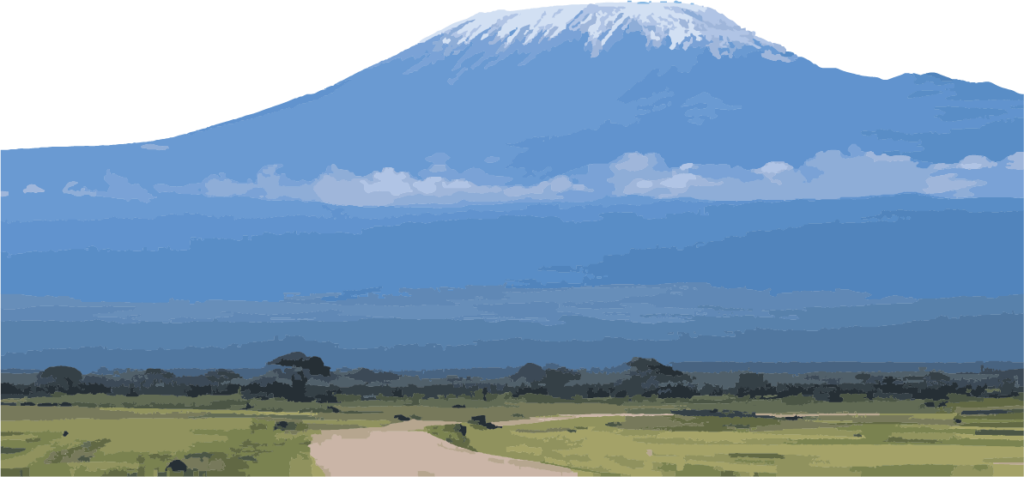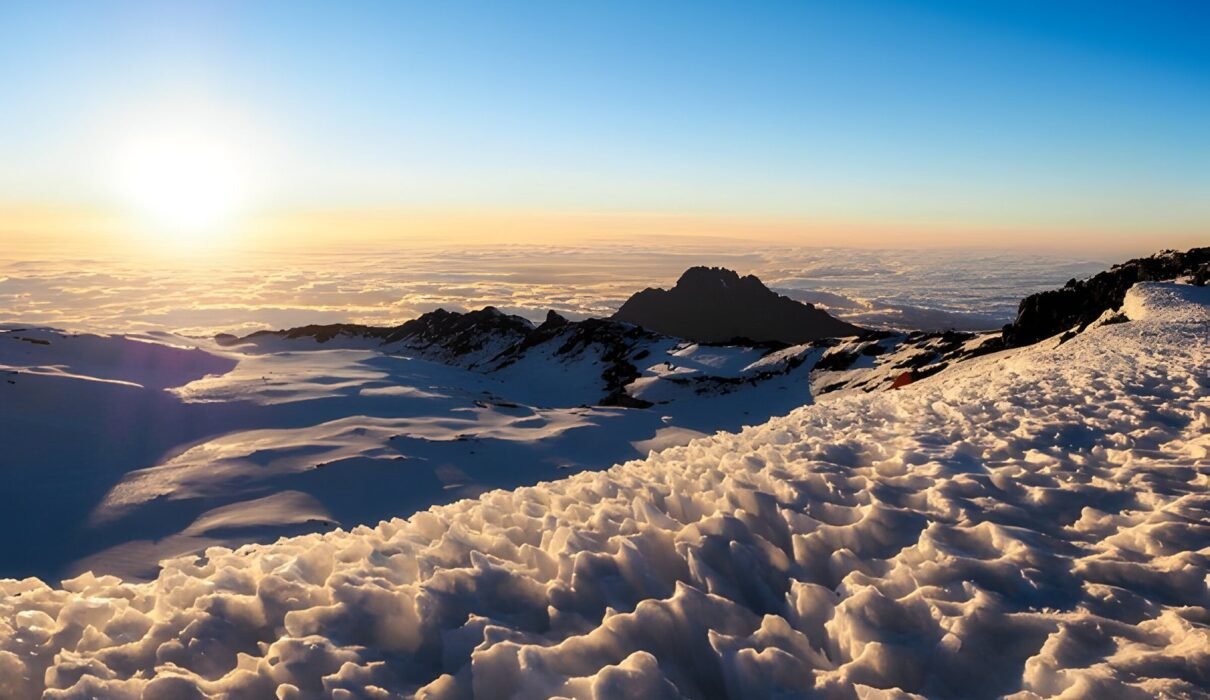Top African Hiking Trails for 2025 : Africa is home to some of the most stunning hiking trails in the world. From the towering peaks of the Atlas Mountains in Morocco to the rugged cliffs of Drakensberg in South Africa, these trails offer a diverse range of landscapes and experiences. Whether you are looking for a multi-day trek or a short scenic hike, Africa has something for every type of adventurer.
In this guide, we will cover some of the top African hiking trails for 2025, giving you all the information you need to plan your perfect hiking trip. To explore more about trekking in Africa, you can visit Kilimanjaro Climb Specialist or Eddy Tours and Safaris for expert advice and booking options.

Top African Hiking Trails for 2025 : Mount Kilimanjaro, Tanzania (Machame Route)
The Machame Route on Mount Kilimanjaro is one of the most popular trails for hikers. Known as the “Whiskey Route,” this path provides a moderate challenge with rewarding views of diverse landscapes, including rainforests, moorlands, and alpine deserts. Reaching Uhuru Peak, the highest point in Africa, is a bucket-list item for many adventurers.
- Elevation: 5,895 meters (Uhuru Peak)
- Duration: 6-7 days
- Best time to hike: June to October, January to February
For more information on Kilimanjaro treks, check out Kilimanjaro Climb Specialist.
Top African Hiking Trails for 2025 : The Atlas Mountains, Morocco
The Atlas Mountains offer some of the most scenic hikes in North Africa. The highest peak, Jebel Toubkal, attracts hikers from around the globe. This trek takes you through Berber villages and lush valleys before ascending the summit, which provides sweeping views of the Sahara Desert and the surrounding mountain ranges.
- Elevation: 4,167 meters (Jebel Toubkal)
- Duration: 2-3 days
- Best time to hike: April to October
Learn more about the Atlas Mountains at Moroccan Atlas Hiking.
Top African Hiking Trails for 2025 : Drakensberg Mountains, South Africa
The Drakensberg Mountains offer a series of hiking routes through rugged terrain, green valleys, and dramatic cliffs. One of the most famous trails is the Amphitheatre Hike, which offers panoramic views of the escarpment and the surrounding landscape. It’s an excellent choice for hikers looking for both beauty and challenge.
- Elevation: 3,482 meters (Thabana Ntlenyana, the highest point)
- Duration: 2-6 days depending on the route
- Best time to hike: March to May, September to November
Check out more information on the Drakensberg hikes at Drakensberg Adventures.
Top African Hiking Trails for 2025 : Simien Mountains, Ethiopia
The Simien Mountains are one of Africa’s most striking landscapes, with jagged peaks, deep valleys, and impressive gorges. The Ras Dashen trek, which leads to Ethiopia’s highest peak, is a challenging yet rewarding trail. Along the way, you may spot wildlife like the Gelada baboon and Walia ibex.
- Elevation: 4,550 meters (Ras Dashen)
- Duration: 5-7 days
- Best time to hike: September to November, March to May
Discover more about hiking in Ethiopia at Simien Mountains National Park.
Top African Hiking Trails for 2025 : Mount Kenya, Kenya
Mount Kenya is Africa’s second-highest mountain and a UNESCO World Heritage Site. It offers several trekking routes, with the Chogoria and Sirimon routes being the most scenic. These trails take you through forests, glaciers, and high-altitude lakes, making for an unforgettable hiking experience. The peak, Point Lenana, is a challenging but non-technical climb.
- Elevation: 4,985 meters (Point Lenana)
- Duration: 4-6 days
- Best time to hike: January to March, June to October
Find out more about trekking Mount Kenya at Mount Kenya National Park.
Top African Hiking Trails for 2025 : Rwenzori Mountains, Uganda
Known as the “Mountains of the Moon,” the Rwenzori Mountains in Uganda offer some of the most remote and challenging treks in Africa. The Central Circuit Trail is the most popular route, leading to Margherita Peak, the third-highest mountain in Africa. The trek takes you through lush forests, glaciers, and stunning alpine scenery.
- Elevation: 5,109 meters (Margherita Peak)
- Duration: 7-9 days
- Best time to hike: December to February, June to August
For detailed information on the Rwenzori Mountains, visit Rwenzori Trekking Services.
Top African Hiking Trails for 2025 : Table Mountain, South Africa
For those looking for a shorter yet iconic hike, Table Mountain in Cape Town, South Africa, is the perfect choice. There are several routes to the summit, with Platteklip Gorge being the most direct. From the top, you’ll be treated to stunning views of Cape Town, the Atlantic Ocean, and the surrounding peaks.
- Elevation: 1,085 meters
- Duration: 2-4 hours
- Best time to hike: All year, with the best weather from November to March
Explore more about hiking Table Mountain at Table Mountain National Park.
Why African Hiking Trails Should Be on Your 2025 List
Diverse Landscapes
Africa offers some of the most varied hiking terrains in the world, from volcanic peaks to lush rainforests. These trails provide hikers with the opportunity to experience vastly different ecosystems, sometimes within the span of a single trek.
Rich Cultural Experiences
Many of these trails pass through remote villages where hikers can engage with local cultures. For instance, trekking through the Atlas Mountains allows you to interact with Berber communities, while hikes in the Simien Mountains take you through traditional Ethiopian landscapes.
Adventure for All Levels
Whether you’re a beginner looking for a scenic day hike or an experienced trekker aiming for a high-altitude summit, Africa’s hiking trails offer something for everyone. From the shorter Table Mountain hike to the demanding Rwenzori treks, there is a trail that matches your skill and fitness level.

Top African Hiking Trails for 2025 : FAQs
1. What is the best time to hike in Africa?
The best time to hike varies by region. For northern Africa (Atlas Mountains), spring and autumn are ideal. In East Africa (Kilimanjaro, Mount Kenya), the dry seasons from June to October and January to February are best. Southern Africa (Drakensberg, Table Mountain) is great for hiking in the cooler months from March to May and September to November.
2. Do I need technical climbing skills for African hiking trails?
Most African hiking trails, including Kilimanjaro and Mount Kenya, do not require technical climbing skills, but they do require good fitness levels. However, some treks like the Rwenzori Mountains involve more technical sections, particularly if summiting Margherita Peak.
3. How can I prepare for high-altitude treks like Kilimanjaro and Mount Kenya?
Preparation includes physical fitness training, proper acclimatization, and packing appropriate gear. For tips on high-altitude preparation, visit Altitude.org.
For more information on trekking tours and hiking experiences, visit Kilimanjaro Climb Specialist or book your next African adventure with Eddy Tours and Safaris.

